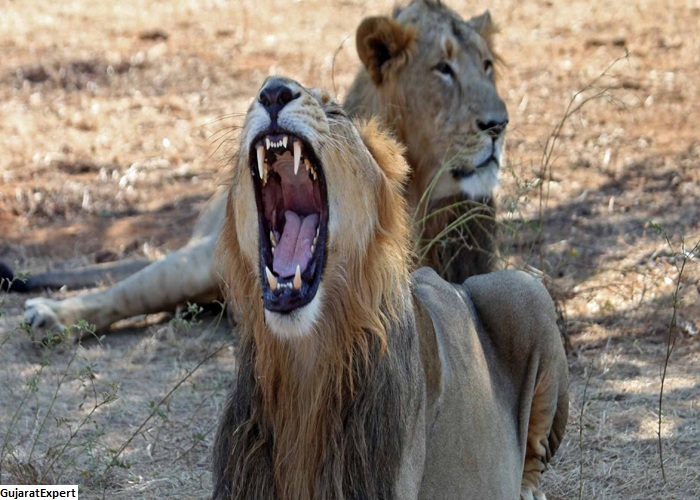
A common perception among people is that deserts are bereft of life. When people think of Kutch, they conjure up vast stretches of sand and little else so what is there to see and do in Kutch? It may come as a surprise but the deserts of Kutch (including the greater Rann of Kutch and the minor Rann are home to myriad flora and fauna. Kutch was a fertile region at one time as is evinced by the ancient site of Dholavira and the fossil beds also show a past in which the region was thickly forested. Today it may be mostly sandy desert land but the area of Kutch is home to a number of wildlife sanctuaries like the Chari Dhand Wetland Conservation Reserve, the Kutch Bustard Sanctuary, Banni Grasslands Reserve, the Indian Wild Ass Sanctuary, the Narayan Sarovar Sanctuary and the Kutch Desert Wildlife Sanctuary. The last is worthy of a visit to discover its hidden gems.
Location
The Kutch Desert Wildlife Sanctuary covers a vast expanse of 7500 square kilometres in the greater Rann of Kutch. It is about 320 km from Ahmedabad and 110 km from Bhuj and it can be reached by road from various points in Gujarat. Ahmedabad, Bhuj and Jamnagar are the closest airports. It is close to the Pakistani border in the north-east side of Kutch.
Origins
The area was officially declared a sanctuary in February 1986 and encompasses forest land, coastal area and barren land as well as stretches of sand.
There are also wetlands in the region and mudflats as well as shoreline that combine to create habits for a wide range of flora and fauna. However, the star attraction is Flamingo City located about 10 km from Nir outpost near Kala Dungar, an area close to the Pak border heavily patrolled by the BSF the only area in the region where flamingoes nest and breed. The Kutch Desert Wildlife Sanctuary is the biggest of such sanctuaries in Gujarat.
Flora & Fauna
The variegated landscape of the Sanctuary offers an interesting mix of flora. The two hills, Kala Dungar and Goro Dungar and surrounding regions are populated with “gando baval” or prosopis chilensis, kahri jar, gugal, Thor, mithi jar, khijdo, hermo baval, kerdo, bokhani and other trees as also shrubs, cactii and grasses. It is worth hiring a car or Jeep or SUV to explore the vast stretches of the Kutch Desert Wildlife Sanctuary and get a closer look at its fauna. The sanctuary is home to animals both carnivorous and non-carnivorous. There are blackbucks, chinkaras and nilgai as well as wildasses. Then there are predators like hyenas, wolves, and foxes in addition to jungle cats, lizards and snakes. As for birds there are dozens of species of which the Flamingo is undoubtedly the most popular. One can come across white pelicans, avocets, the great Indian bustard, painted sandgrouse, larks steppe eagles and waterfowls. During the daytime the animals may not be active but dawn and dusk is the time to see them near watering holes.
Flamingo City
The area known as Flamingo City is in the mudflats region, about 10 km from Kala Dungar Nir outpost. In addition to a million flamingoes there are also other birds like the rosy pelican and avocets, creating a virtual din with their cackling. Just before the monsoon water dries out is the best time to view them in their glorious plumage. Bird lovers might like to travel a little way to Narayan Sarovar Lake, another site that is home to migratory birds. In all there are over 184 bird species to be found at Narayan Sarovar Sanctuary.
Dholavira
The Kutch Desert Wildlife Sanctuary attracts visitors who are more interested in archaeology and for them Dholavira is the target, a repository of 5000 year old Harappan civilization spread over 48 hectares in Khadir Bet or the small island of Khadir. Even if one is not interested in relics, this site is worth a visit during the tour of Kutch Desert Wildlife Sanctuary.
Why Visit
If you love to commune with nature and do not like to be constrained by small places or the presence of guards or restrictions, then this wildlife sanctuary in Kutch is for you. You can travel off the beaten track, set up a tent in the lonely stretches along the coast and spend a night with no one the wiser. You can live off the land like the locals do. However, a couple of days are good enough and a week to ten days is ideal.
A trip is rewarding as one can see how even barren stretches of land are alive with life and one can see how they have adapted to their surroundings. It is also about environment and knowing how all life forms are interconnected and dependent on each other.
From here on can take side excursions to Narayan Sarovar, to the Wild Ass Sanctuary and to the small Bustard Sanctuary as well.
Best Time to Visit
Summers in the Kutch desert can be scorching hot. The best time is winter. However, just after rains could be an equally good time when there are still water bodies around and there is plenty of greenery around. Nature smiles winter is for birders. It can be pleasant during the day but nights in the desert can be quite cold and you will need woollens.
Make Rapar your base town and find a suitably decent hotel here. You can drive off to all points in your own car or jeep or a rented car and explore the sanctuary. Be sure to carry plenty of water bottles and some food.


Leave a Reply